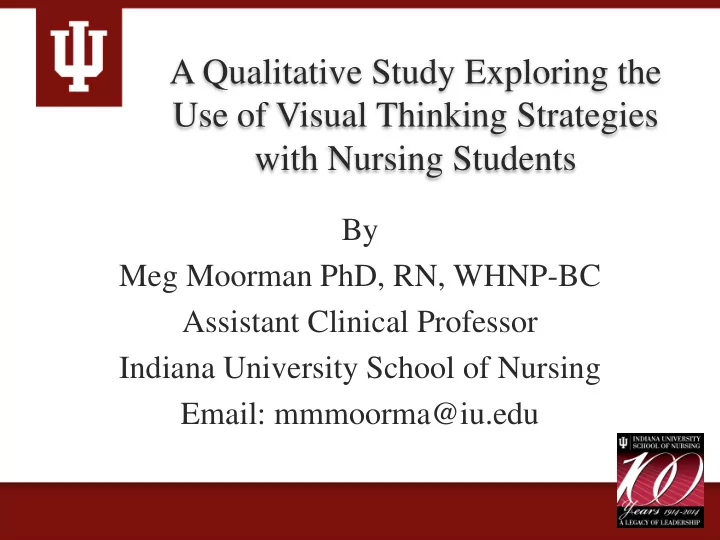

A Qualitative Study Exploring the Use of Visual Thinking Strategies with Nursing Students By Meg Moorman PhD, RN, WHNP-BC Assistant Clinical Professor Indiana University School of Nursing Email: mmmoorma@iu.edu
What is Visual Thinking Strategies? Visual Thinking Strategies (VTS) is a teaching method that uses art to engage participants in conversations using visual evidence for what they see. Created by Abigail Housen and Philip Yenawine Studied in primary education 1
2
Questions Used in VTS 1. What is happening in this picture? 2. What are you seeing that makes you say that? 3. What more can you find? 3
Purpose of Study • Nurse educators are called on to create innovative experiences for students in order to prepare nurses to work in complex healthcare settings. • The purpose of this study was to explore the meaning of VTS for nursing students and how they used it in caring for their patients. 4
Methods • Students enrolled in the 7th semester of an 8 semester Bachelor of Science in Nursing program were recruited • Nine students recruited to participate who had experienced VTS in their 6 th semester OB course • Participated in 2 1-hour VTS experiences at local art museum with trained VTS facilitator • Interviews with researcher were audio taped • Informed consent obtained 5
Methods (continued) Questions: • What meaning does VTS have for nursing students? • How do students who have experienced VTS use it in the care of their patients? Interviews were transcribed and analyzed for common themes Heideggarian hermeneutics used as research method and for analysis Research team analyzed data for themes 6
Themes that emerged from student interviews • Feeling safe in learning • Seeing differently • From view of researcher, theme emerged about process of VTS Facilitative Teaching 7
Feeling Safe in Learning • No right or wrong • All responses given equal acknowledgement • Students reported feeling heard • Facilitator is attentive to student and no prior knowledge of art required • Students more likely to participate when they are not judged and can think out loud 8
Feeling Safe in Learning • Students linked interactions with artwork directly to patient care • Students used same line of questioning form VTS to elicit more information from other care givers 9
Feeling Safe in Learning “ What is going on in this painting ?” • After student answers, facilitator repeats back and paraphrases what student said. • Seeks understanding from student • Allows for clarification Facilitator asks “Tell me what you are seeing that makes you say that?” • Student looks deeper and gives visual evidence for what he/she is seeing • More students participate after seeing that there is no right answer 10
Seeing Differently Facilitator asks “What are you seeing that makes you say that?” • Student gives evidential reasoning • Other students hear how student came up with answer, providing insight into thoughts • All answers given equal attention, so students can hold the possibility of multiple answers 11
Seeing Differently • Looking at art as large piece, then breaking it down into smaller pieces • “Seeing the big picture” and relating it to clinical work 12
Facilitative Teaching From researcher perspective, themes emerged about VTS process that can be used to encourage students to participate 13
Facilitative Teaching In Action Themes Educational Rationale How to incorporate into teaching practice Validation Promotes speaking out Paraphrase student response Ask “Tell me how you came to that conclusion: and paraphrase back to student Ask “Did I understand you correctly?” 14
Facilitative Teaching In Action Themes Educational Rationale How to incorporate into teaching practice Reformation of VTS Formulation/ Display complicated Processes in Clinical Reformulation work of art during class and ask “What is going Practice on in this painting?” Ask “What are you seeing that made you say that?” Paraphrase back Provide picture of complicated patient scenario and repeat above questioning like VTS 15
Facilitative Teaching In Action Theme Educational Rationale How to incorporate into teaching practice Mutual Respect Mutual respect in Invite participation learning and education Seek understanding of student’s view Ask for rationale Paraphrase and seek understanding of response Model mutual respect No judgment or criticism 16
References Benner, P., Sutphen, M., Leonard, V., & Day, L. (2010). Educating nurses: A call for radical transformation, Stanford, CA: Jossey-Bass. Dalley, K., Candela, L., & Benzel-Lindley, J. (2008). Learning to let go: The challenge of de-crowding the curriculum. Nursing Education Today, 28, 62-69. Giddens, J. (2007). A survey of physical assessment techniques performed by RNs: Lessons for nursing education. Journal of Nursing Education, 46, 83-87. Housen, A. (2001). Eye of the beholder: Research, theory and practice. Visual Understanding in Education (VUE), 1-26. 17
References Klugman,C.M., Peel, J., & Beckamnn-Mendez, D. (2011). Art rounds: Teaching interprofessional students visual thinking strategies at one school. Academic Medicine , 85, 1266-1271. Naghshineh, S., Hafler, J.P., Miller, A.R., Blanco, M.A., S.R., Dubroff, R.P., & Katz, J.T. (2008). Formal art observation training improves medical students’ visual diagnostic skills. Journal of General Internal Medicine , 23, 991-997. Vygotsky, L.S. (1993). The collected works of L.S. Vygotsky, Vol. 2. New York: Plenum Press. VTS website: http://www.vtshome.org/ 18
19
20
21
22
Recommend
More recommend